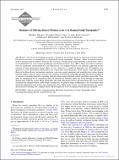Dynamics of eddying abyssal mixing layers over sloping rough topography
Author(s)
Drake, Henri F; Ruan, Xiaozhou; Callies, Jörn; Ogden, Kelly; Thurnherr, Andreas M; Ferrari, Raffaele; ... Show more Show less
DownloadPublished version (3.390Mb)
Publisher Policy
Publisher Policy
Article is made available in accordance with the publisher's policy and may be subject to US copyright law. Please refer to the publisher's site for terms of use.
Terms of use
Metadata
Show full item recordAbstract
<jats:title>Abstract</jats:title>
<jats:p>ABSTRACT: The abyssal overturning circulation is thought to be primarily driven by small-scale turbulent mixing. Diagnosed watermass transformations are dominated by rough topography “hotspots”, where the bottom-enhancement of mixing causes the diffusive buoyancy flux to diverge, driving widespread downwelling in the interior—only to be overwhelmed by an even stronger up-welling in a thin Bottom Boundary Layer (BBL). These watermass transformations are significantly underestimated by one-dimensional (1D) sloping boundary layer solutions, suggesting the importance of three-dimensional physics. Here, we use a hierarchy of models to generalize this 1D boundary layer approach to three-dimensional eddying flows over realistically rough topography. When applied to the Mid-Atlantic Ridge in the Brazil Basin, the idealized simulation results are roughly consistent with available observations. Integral buoyancy budgets isolate the physical processes that contribute to realistically strong BBL upwelling. The downwards diffusion of buoyancy is primarily balanced by upwelling along the sloping canyon sidewalls and the surrounding abyssal hills. These flows are strengthened by the restratifying effects of submesoscale baroclinic eddies and by the blocking of along-ridge thermal wind within the canyon. Major topographic sills block along-thalweg flows from restratifying the canyon trough, resulting in the continual erosion of the trough’s stratification. We propose simple modifications to the 1D boundary layer model which approximate each of these three-dimensional effects. These results provide <jats:italic>local</jats:italic> dynamical insights into mixing-driven abyssal overturning, but a complete theory will also require the <jats:italic>non-local</jats:italic> coupling to the basin-scale circulation.</jats:p>
Date issued
2022Department
Massachusetts Institute of Technology. Department of Earth, Atmospheric, and Planetary SciencesJournal
Journal of Physical Oceanography
Publisher
American Meteorological Society
Citation
Drake, Henri F, Ruan, Xiaozhou, Callies, Jörn, Ogden, Kelly, Thurnherr, Andreas M et al. 2022. "Dynamics of eddying abyssal mixing layers over sloping rough topography." Journal of Physical Oceanography.
Version: Final published version